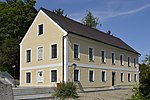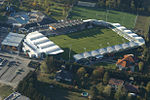DP Camp Haid
The DP camp Haid, officially Wohnsiedlung 121 Haid, was a camp for displaced persons, first under American administration, then Upper Austrian administration. It was located in the district of Haid, Ansfelden in Upper Austria. Displaced persons were civilians who were affected by the turmoil of World War II, first with unknown residence. After the Second World War Ansfelden belonged to the American occupation zone. The camp was set up by the American military administration at the existing labor camp of the Wehrmacht from 1945. In September the same year between 8,000 and 9,000 captured SS men were guarded by American soldiers in the camp, who had to continue efforts to expand. In the following years, the camp was populated with displaced Jews from Poland and the homeless from Yugoslavia, Romania, Hungary, Germany, Czechoslovakia and Transylvania, Sudeten Germans and Croats. In October 1956, when in Hungary the uprising against Communist rule with was crushed by Russian armored troops, some 700 refugees arrived in the last stocks of the camp.
Excerpt from the Wikipedia article DP Camp Haid (License: CC BY-SA 3.0, Authors).DP Camp Haid
Adalbert-Stifter-Straße,
Geographical coordinates (GPS) Address Nearby Places Show on map
Geographical coordinates (GPS)
| Latitude | Longitude |
|---|---|
| N 48.203888888889 ° | E 14.253888888889 ° |
Address
Adalbert-Stifter-Straße 4
4053
Austria
Open on Google Maps








